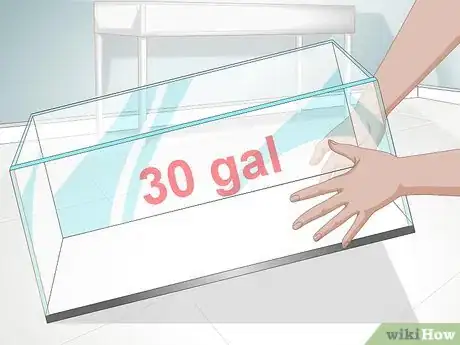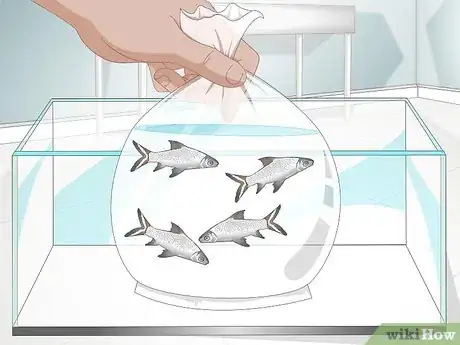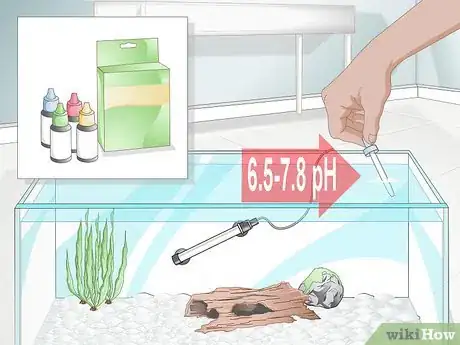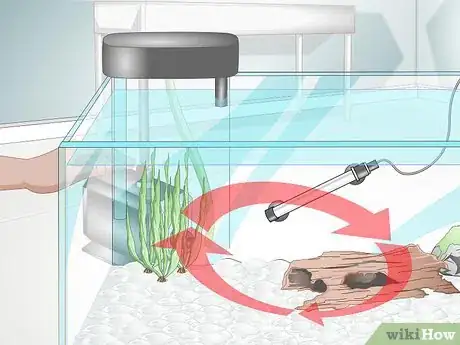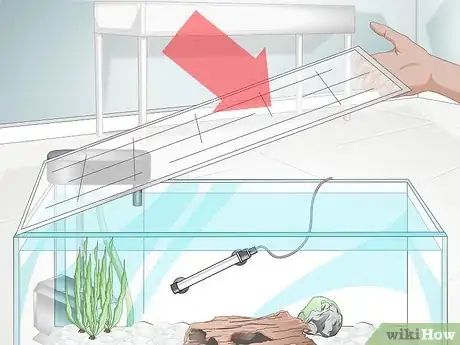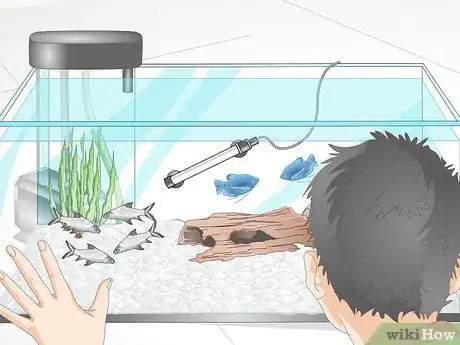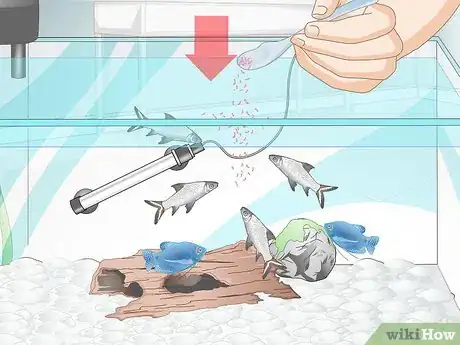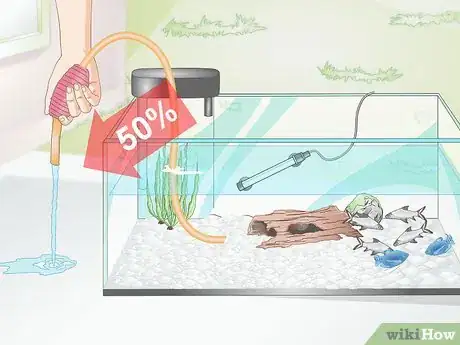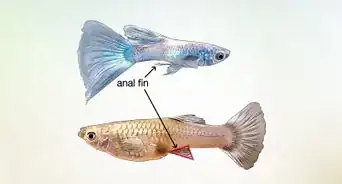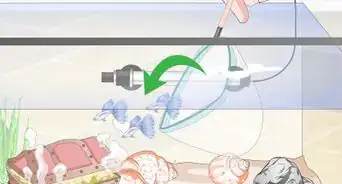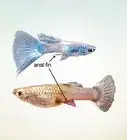This article was co-authored by wikiHow Staff. Our trained team of editors and researchers validate articles for accuracy and comprehensiveness. wikiHow's Content Management Team carefully monitors the work from our editorial staff to ensure that each article is backed by trusted research and meets our high quality standards.
There are 8 references cited in this article, which can be found at the bottom of the page.
wikiHow marks an article as reader-approved once it receives enough positive feedback. In this case, 81% of readers who voted found the article helpful, earning it our reader-approved status.
This article has been viewed 169,251 times.
Learn more...
Bala sharks are freshwater fish from Southeast Asia. They are not actual sharks, but were named this way because of the shark-like appearance of their topedo-shaped bodies and rigid dorsal fins.[1] Any resemblance ends there, as they are generally gentle fish with an active social habit. Taking good care of bala sharks involves selecting the right tank, ensuring the best water chemistry, finding agreeable neighbors, and making sure to clean the tank and change its water regularly. If you give them the attention they need, these popular and attractive fish can provide you with years of enjoyment.
Steps
Preparing the Habitat
-
1Decide on a tank size. Since bala sharks can grow to 12 inches (30.5 cm) in captivity, they will need a fairly large tank. If you get them as juveniles, they will be fairly small at around 3 inches (7.6 cm)[2] At this size they can do do well in a tank holding a minimum of 30 gallons (114 liters) and of a length of 30 inches (76.2 cm). But as they grow, they will need a minimum of 150 gallons (568 liters) and a tank length of at least 72 inches (182.9 cm).[3]
-
2Choose a quantity. Bala sharks are considered shoaling or schooling fish, which means they live in groups. So you’ll need to buy a group of between four and six fish to ensure that they’ll get along well with each other and stay in good health.[4]
- A lone bala shark tends to become aggressive with other fish. And if kept in pairs, the dominant one is known to bully the other.[5]
Advertisement -
3Furnish the tank sparingly. Being larger fish, bala sharks need plenty of tank space for swimming, so don’t overcrowd them. A few plants around the perimeter of the tank, and some wood for shelter and decor, should be plenty. Provide a bed of rocks that is darker in color--this will allow the fishes’ silvery color to stand out better, and also helps them to feel secure.[6]
-
4Set up a heater. Since these fish come from a tropical environment, and will be living in a large tank, they’ll need a good heater to keep the large amount of water at the right temperature. An appropriate temperature range is 72 to 80 degrees Fahrenheit (22.2 to 26.7 degrees Celsius).[7]
-
5Monitor the water’s hardness and pH. Fill the tank with fresh water from the tap, and test its pH and hardness levels. Appropriate ranges are 6.5 to 7.8 for pH, and a water hardness of 2 to 10 dGH.[8] Ask a tank specialist at the pet store about available gauges for monitoring these levels.
- If you live in an area that takes its water from wells in limestone bedrock, the tap water will tend to be on the harder side. If the water comes from lakes, it will usually be softer.
- While you can buy chemicals to adjust pH, you can also use peat in the tank or filter to raise acidity, and calcium salts to raise alkalinity.[9]
-
6Ensure enough water movement. Since bala sharks are river fish, they are adapted to aquatic environments with steadily moving water. Buy a filter for your tank that is powerful enough to keep a steadily moving current running and provide enough oxygen for the fish.
- A large canister filter can take care of oxygen, current, and water purity. A powerhead can help increase the current in larger tanks.[10]
-
7Select appropriate tankmates. Bala sharks are known to be peaceful and rarely aggressive. But their fast swimming and skittishness can cause stress for calmer species. They get along well with fish that have similar personalities,[11] such as larger cichlids, angelfish, parrot cichlids, medium-size tetra, gouramis, and ram cichlids.
- Try to keep bala sharks with other species at least half their size. They tend to see any fish small enough to fit in their mouths, such as smaller tetra, as food.[12]
-
8Get a tight-fitting lid. When they are startled, bala sharks react by quickly moving away from what scares them, or jumping. They are known to leap as high as six feet out of an open tank. So be sure to outfit your tank with a tight-fitting lid.[13]
Providing Proper Care
-
1Acclimate them carefully. To help your bala sharks adjust to their new tank water, they’ll need to be acclimated. Remove ¼ of the their bag water and replace it with an equal amount from the tank. Then place them in the tank while still in their plastic water bags, and add one cup (237 milliliters) of tank water to the bag every ten minutes for one hour. Finally, gently net the fish from the bag, and dispose of the bag and its water.[14]
-
2Expect an adjustment period. After bringing the fish home and putting them in the tank, you might notice that they are shy at first, and may not eat for a few days. This is normal behavior, because of the fright they experience during the trip from the store to your tank.
- Be careful not to overfeed them during this period--try giving them small amounts a few times a day until their appetite improves.[15]
-
3Feed them a broad diet. Bala Sharks like a variety of foods, including flakes, brine shrimp, mosquito larvae, chopped fruit, blanched spinach, shelled peas,[16] sinking wafers, and live black worms.[17] Generally, give them an even mixture of vegetable matter, flakes, and live food.[18]
- Try to feed them 2 to 3 times per day. At each feeding, give them as much as they're able to eat in 3 minutes. If you only feed them once a day, give them what they can eat in 5 minutes.[19]
-
4Change the water frequently. To keep your bala sharks in good health, they’ll need regular water changes. Replace 50% of the water at least once a month, and replace 25% at least every other week if the tank is densely populated.
- When you replace the water, this is also a good time to clean the bottom of the tank, including rocks, with a vacuum siphon. Use an algae scraper as well to clean the glass panes.[20]
Community Q&A
-
QuestionAre there any infections that Bala sharks are susceptible to that I should be aware of?
 Community AnswerThey are more likely to contact ich when stressed.
Community AnswerThey are more likely to contact ich when stressed. -
QuestionWhat is the best food to feed a Bala shark if it won't eat pellet food?
 Community AnswerTry some flake food, but make sure that you get the kind that are appropriate for Bala sharks. A bit of blood worms or brine shrimp every now and then is quiet a treat for them as well!
Community AnswerTry some flake food, but make sure that you get the kind that are appropriate for Bala sharks. A bit of blood worms or brine shrimp every now and then is quiet a treat for them as well! -
QuestionIs it okay to have just one Bala shark in my tank or do I need more?
 Community AnswerBala sharks like to be in the company of other Balas, four or more seem to be the preference, but two or more tend to live longer than just one.
Community AnswerBala sharks like to be in the company of other Balas, four or more seem to be the preference, but two or more tend to live longer than just one.
Warnings
- Since bala sharks can can become frightened quite easily, give them as gentle a ride home from the pet store as possible.⧼thumbs_response⧽
Things You'll Need
- Air Pump
- Ammonia test kit
- Appropriately sized Aquarium
- Driftwood or other ornaments (Optional)
- Heater
- Hood with lighting
- Live/Artificial plants
- Nitrate Nitrite test kit
- pH test kit
- Proper Filtration
- Substrate
References
- ↑ http://animal-world.com/encyclo/fresh/cyprinids/balashark.php
- ↑ http://www.aquariumlife.net/articles/tropical-fish/bala-shark/204.asp
- ↑ http://animal-world.com/encyclo/fresh/cyprinids/balashark.php
- ↑ http://www.aquariumlife.net/articles/tropical-fish/bala-shark/204.asp
- ↑ http://animal-world.com/encyclo/fresh/cyprinids/balashark.php
- ↑ http://animal-world.com/encyclo/fresh/cyprinids/balashark.php
- ↑ https://www.youtube.com/watch?v=xMVHYokEgYU
- ↑ http://animal-world.com/encyclo/fresh/cyprinids/balashark.php
- ↑ http://www.peteducation.com/article.cfm?c=16+2154&aid=1526
- ↑ http://animal-world.com/encyclo/fresh/cyprinids/balashark.php
- ↑ http://animal-world.com/encyclo/fresh/cyprinids/balashark.php
- ↑ https://en.aqua-fish.net/fish/bala-shark
- ↑ http://www.aquariumlife.net/articles/tropical-fish/bala-shark/204.asp
- ↑ http://www.fishlore.com/acclimating-tropicalfish.htm
- ↑ https://www.youtube.com/watch?v=xMVHYokEgYU
- ↑ http://animal-world.com/encyclo/fresh/cyprinids/balashark.php
- ↑ http://www.aquariumlife.net/articles/tropical-fish/bala-shark/204.asp
- ↑ https://en.aqua-fish.net/fish/bala-shark
- ↑ http://animal-world.com/encyclo/fresh/cyprinids/balashark.php
- ↑ http://animal-world.com/encyclo/fresh/cyprinids/balashark.php
About This Article
To keep a bala shark through adulthood, you’ll need a tank that holds at least 150 gallons and is at least 72 inches long. For a juvenile bala shark, a tank that holds 30 gallons of water will work, but the fish will outgrow this size. Keep the decorations in the tank to a minimum so the fish will have plenty of room to swim, and place a tight-fitting lid on the tank so the fish can’t jump out. Feed your fish an even assortment of vegetable matter, flakes, and live food. For tips on choosing tankmates for your fish, keep reading!
